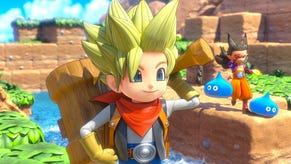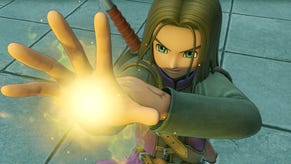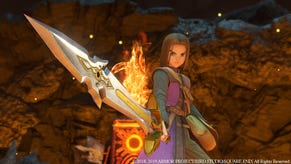Can Japan's Games Industry Overcome Last Gen's Slump?
This year's Tokyo Game Show was the strongest in years. Is it a sign of better things to come? Anecdotally speaking, yes.
This article first appeared on USgamer, a partner publication of VG247. Some content, such as this article, has been migrated to VG247 for posterity after USgamer's closure - but it has not been edited or further vetted by the VG247 team.
Hunting for classic games in Tokyo isn't what it used to be. That is a heartbreaking loss, because no single place in the world curates video game history as a matter of course more actively or effectively than Tokyo.
It's hard to say why, exactly, Japan has been so much better than the rest of the world about preserving its game heritage, yet it's true. You'd be hard-pressed to find a mint-in-box copy of an old NES game in the U.S. without going to a special event like Classic Games Expo or paying someone's exorbitant mark-up on eBay. In big Japanese cities like Tokyo or Osaka, however, finding a nicely kept game from the '80s is no more difficult than hopping on the train and heading to the nearest shop that specializes in classic video games.
Admittedly, this narrative works best if you're hunting for Famicom (NES) or Super Famicom (Super NES) titles. Other consoles tend to be fairly hit-or-miss, with poor showings and high prices in retro shops. Nintendo's old consoles, on the other hand, are everywhere. Small wonder: Famicom was the popular system in Japan during the '80s, breaking out just as the country leapt headlong into an unprecedented economic boom fueled by the nation's reconstruction in the wake of World War II's devastation. Dozens, possibly hundreds of publishers scrambled to get in on the Famicom gravy train. The most popular games could be assured of selling several million units, and even the lesser releases had a good shot at not only breaking even but making a tidy profit. Many of the doughty mainstays of today's games industry — Capcom, Atlus, Konami, Square Enix — enjoyed their first big break on Famicom.
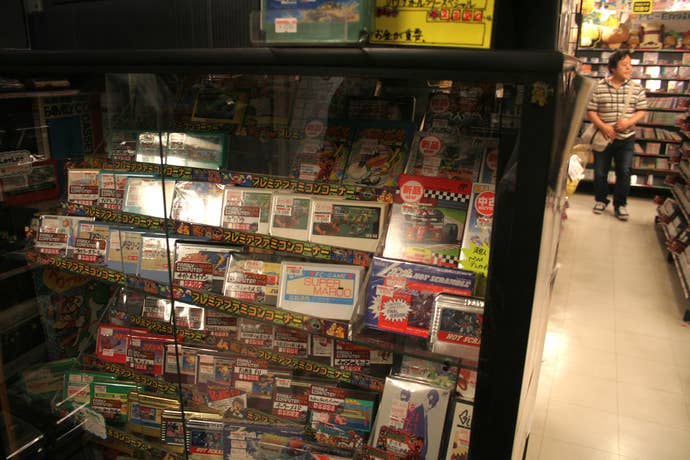
Still, belovedness alone can't account for the ubiquity of classic games in Tokyo. Americans love NES games, too, but good luck finding anything older than PlayStation 2 at your local GameStop. Much of the convenience of classic game hunting in Japan comes down to sheer density; more than 10% of the country's population lives in Tokyo, while the greater Tokyo area (which includes nearby cities like Saitama, Yokohama, and Chiba) is home to more than a third of all Japanese citizens. It's a small nation, too; you can travel from one end to the other of the largest island, Honshu, in less than eight hours via shinkansen bullet train.
When so many people jam themselves into such a small area, the nature of commerce changes. Specialist shops pop up to cater to every need imaginable, and Tokyo parcels out its consumer wares according to neighborhood. Ikebukuro and Harajuku cater to the fashionable; Ginza is for high-end shopping; Roppongi and Shinjuku serve baser needs; and, of course, Akihabara caters to nerds and geeks of all stripes.
Like much of the rest of modern Tokyo, Akihabara's "electric town" areas developed during the post World War II era. As Japan reinvented itself as a manufacturing powerhouse, Akihabara remade itself as the source of and supplement to all those gadgets. It was like a vastly more comprehensive Radio Shack spread across an entire neighborhood, and you can still find a few back-alley businesses that maintain the tradition of DIY parts for tinkerers whence Akihabara sprang.
Japanese companies like Sony and Sanyo became world leaders in consumer electronic design in the '70s and '80s, and as that sector of industry rocketed to global acclaim, Akihabara began to see more consumer-focused shops that specialized in finished electronics rather than simply parts. Once the Famicom boom began in earnest in 1984, Akihabara's mix of retailers made it the perfect destination for buying systems and games. And when Famicom owners grew tired of their purchases, retailers began accepting trade-ins — a service that became doubly valuable when the nation's courts struck down the right of Japanese consumers to rent games.
Given the high price of new software releases in Japan — standard releases in the 16-bit days sometimes clocked in at the equivalent of $100 (and that's in '90s dollars) — the opportunity to trade in old games became an essential part of the games market. Combine the need for a steady trade-in business with the fact that millions of enthusiasts with money to burn were packed into a single metropolitan area and you have the makings of a rich secondary market.
What really sets Japanese second-hand games apart from the few you'll find in America or Europe, though, has everything to do with their remarkable degree of preservation. While you can find rack upon rack of bare 8-bit carts in Japanese shops, you can also find scores of complete-in-box games from 30 years ago. Many shops grade these archival titles on a three-point system, rating the box, the cart, and the other contents on a letter scale that typically runs from A through C. These gradings can have a huge impact on the cost of a game; an all-A copy of a relatively rare release like Akumajou Densetsu (Castlevania III) can cost you two to three times as much as one with even a single C-grade attribute.

The thing is, what most retailers deem a "C" amounts to what casual collectors would consider negligible flaws — a bent corner, a spot where ink has rubbed off a box flap. While these are considered killer shortcomings by Japanese fans, you'd be lucky to find an old American 8-bit game in equally "poor" condition. Savvy eBayers have cottoned to this fact; they'll snatch up C-grade (or worse) Japanese titles for cheap, then flip them online to eager importers for massive markups. Meanwhile, what few retro specialist shops exist in America — Manhattan's Video Games New York, for example — charge eBay prices plus a premium for ragged, dog-eared packaging that a Tokyo shop like Super Potato or Mandarake Galaxy would reject without a second glance.
For fans of classic console games, Tokyo has long represented a sort of paradise. An American gamer's first trip to Akihabara inevitably sends them into paroxysms of glee, like an overstimulated ferret, marveling at these perfectly preserved slices of history available for generally reasonable prices. You can even find well-kept American releases, often for considerably less than they'd sell for in the U.S.
The gap between us and them is beginning to close, however, and not because America has stepped up its game. Rather, Japanese retro game shops have begun to diminish in quality. Over the past decade, a number of great retro game outlets all across Japan have shut down. Meanwhile, generalist shops that sold classic games in addition to other merchandise now focus strictly on that other merchandise. Large media chains like Tsutaya have whittled down their retro selections to a handful of remnants. The original Osaka-based location of popular chain Super Potato — easily the most popular destination for game-loving foreigners thanks to the store's savvy willingness to break from Japan's universal "no photos" policy — recently closed down and moved into a far smaller building.

Don't get me wrong; you can still find classic games in Japan far more easily than anywhere else in the world. The Tokyo retrogame shopping guide I put together last year remains wholly accurate — none of the shops listed there have closed down in the interim. Yet even so, the selections have grown more limited even at these locales. Interesting and desirable games have grown harder to find, or are more likely to be featured in a shop's pricey premium display cases. At Mandarake Galaxy, the rarities showcase in front of the shop includes fewer unique Famicom games and has begun to display more books, fanzines, and titles for obscure systems. Gone are the days of crazy oddities like an official Super Famicom flash cartridge containing the download-only sequel to Chrono Trigger, Radical Dreamers, for close to $1000. Now it's sheet music and old LCD handhelds — interesting, but generally much less of a showpiece than the high-end rarities like Archimendes Gradius (all the power-ups are replaced with bowls of Archimendes ramen) or the exclusive gold Rockman 4, aka Mega Man 4 (only eight were ever produced).
In short, the classic games market in Japan teeters at the brink between stagnation and shrinkage. But the problem isn't that Japanese gamers have lost their interest in the classics; rather, it's that they're losing their interest in games.
Not-so-big in Japan
This is hardly news, of course. The Japanese games industry has been shrinking for a while.
Several people I spoke to while I was in Tokyo for TGS this year attributed the change to the country's aging population. While Japan's overall population numbers actually show a decline, its population of senior citizens is growing. In fact, the over-65 demographic has grown by nearly 15% over the past decade, and Japan's elderly account now for approximately a quarter of the population. The median age of video game players the world over has risen considerably over the past decade, but not that much; Japan is literally outgrowing the medium.
There's still growth to be found at the other extreme of the age spectrum; million-selling console games have become something of an endangered species in Japan, but Level-5's Yokai Watch 2 recently sailed past the two million mark in a few weeks (it sold more than a million units in its first weekend on the market alone) on the strength of school kid obsession. Still, it's the exception rather than the rule... and much like the Pokémon series, its success isn't strictly about the game.
"My kids love it," says a friend. "But really that's because of the toys and the cartoons. The game is just a part of that bigger brand."

The Yokai Watch brand joins the rarified ranks of Japan's last remaining video game properties that remain capable of cracking the seven-digit figure in their home market, a shrinking pool that includes the usual suspects: Monster Hunter, Dragon Quest, and a slate of Nintendo games ranging from Smash Bros. to Animal Crossing. Among these, even stalwart Dragon Quest has been struggling somewhat; the most recent entry in the series, Dragon Quest X, fell well short of the million mark at launch due to being an MMO (its predecessor, Dragon Quest IX, pre-sold more than two million copies). Of course, MMOs use a different business model; Square Enix sacrificed raw sales figures to pursue long-term profits from committed fans. Dragon Quest XI will presumably return to a single-player console experience — franchise boss Yuji Horii has expressed his desire to play the game on "a big screen" — though it's hard to say which console it will appear on. None of the current systems have made any headway in Japan; even the PlayStation 4, a runaway hit worldwide, has done so poorly in its home territory that it makes the Wii U's troubled performance in the West look like the very definition of success.
Unsurprisingly, the other growth sector for games in Japan continues to be mobile software. Of the more than 1350 games shown at Tokyo Game Show 2014, about 550 were for mobile platforms, up from about 250 in 2013. Meanwhile, games for other platforms clocked in at 315, up (just barely) from 2013's total of 309. TGS doesn't offer an entirely accurate picture of the Japanese games industry, since Nintendo — which continues to dominate the console market over there — has never attended the event. But even the presence of their first-party software wouldn't do much to tilt the growth numbers back in favor against the mobile market.
Even big console-centric franchises make concessions to the rise of mobile, as seen in the recent Dragon Quest remakes. While many fans of the series find the mobile ports frustrating, design choices that may appear to be shortsighted flaws are in fact present by choice. I recently asked series producer Yosuke Saito why the mobile ports don't allow for play in landscape format or with bluetooth controls. After making some threadbare excuses about App Store size limitations, he finally admitted, "These games are really meant to be played one-handed."
"As in, on the train?" I asked as I mimicked holding a phone with one hand and an overhead subway strap with the other. Saito laughed and nodded.
You don't need hard numbers to get a sense of the growing popularity of mobile games in Japan. Where once cell phones were far less common on trains than DS and PSP systems, these days they greatly outnumber game consoles of any sort.
Besides the essential need for games that can be played in a crowded commuter train, the reasons behind the growth of mobile games in Japan isn't terribly different from the format's growing ubiquity in the West. Mobiles games are inexpensive, and they run on devices everyone already owns and uses. Although Americans tend to think of Japan as a gaming Mecca where everybody of all ages loves gaming and considers it cool, in truth video games are considerably less socially acceptable in Japan than America.

"Video games are for kids here," one Japanese native told me recently. "Adults who play games on the train are seen as pretty strange." Thus, she said, mobile games — which could just as easily be text messaging or web browsing, for all an outside observer can tell — give game fans a form of social camouflage as they partake of their pastime.
That probably sounds familiar to many Americans. For example, a few years back, Nintendo tried to sell the Game Boy Micro as a sleek device for adults, but critics at the time widely derided this claim. "No one is going to whip out a Game Boy of any kind at a bar," one of my coworkers at the time scoffed. But an iPhone game? Half the world is already glued to their phone screens anyway; does it really matter if you're checking in on Yelp or flinging a furious avian?
But this is particularly true in Japan, where conformity and image hold notorious sway. Further fueling the issue has been the rise of an entire subculture of gamers devoted to a very specific breed of games, heavy on the fanservice and just as heavily looked down on by the general gaming public. Call them moé, call them gal games, call them otaku-bait; whatever the term you prefer, these works share certain a certain theme in common: Girls, usually young, often underdressed, frequently objectified. For many people, these are what comes to mind when they hear the term "Japanese games."
The anime boudoir
Visitors to this year's Tokyo Game Show found themselves greeted by what could best be termed a moé boudoir. As attendees descended the escalator at Kaihinmakuhari Station, the nearest train terminal to TGS's long-time home at Chiba's Makuhari Messe convention center, they found themselves flanked by a series of posters that depicted cartoon girls undressing. Well, I say "girls," but it's hard to say how old the characters were meant to be, as they were depicted entirely from mid-torso down. The images emphasized them hiking up their skirts and slipping off garters, cropping out superfluous details like faces. Given the predilection many otaku-oriented games have for sexualizing teenagers, though, "girls" rather than "women" seems a safe assessment.
As the first image TGS attendees saw this year after disembarking from the train to the show, these posters seemingly set the tone for the event. Yet in reality, this expectation wasn't particularly borne out by the TGS exposition floor itself. The games that drew the crowds were rarely the ones that depicted young girls in various states of undress. On the contrary, those slipped more or less beneath the radar at the show itself.
Instead, the crowds were drawn to much less salacious fare: Live demos of Metal Gear Solid V, the eternal queues for Monster Hunter and Sony's Morpheus, and a number of different Final Fantasy demos and stage presentations. The most prurient booth at the entire show belonged to D3 Publisher, whose Oneechanbara kiosk required players to place their faces inside holes in a billboard depicting its bikini-clad protagonist Aya; the holes were placed directly over Aya's breasts.
Yet just on the other side of D3's booth, near the sizable indie game area, Votlage had set up an amusing form of counter-programming to D3's grotesque demo kiosk: A ladies-oriented photo booth where women could pose for glamor shots involving beautiful young men fawning over them. It's the first time in my decade of covering TGS that I've ever seen a booth so decidedly geared toward women — a real novelty amidst the bikini armor and the usual array of booth babes and their throngs of thongs. But a welcome novelty, too, one that better represents the actual makeup of the TGS crowd, which on public days contains tens of thousands of girls and women.
The overwhelmingly male-oriented nature of TGS promotions reflects a perception problem Japanese games as a whole suffer from: That is, the idea that "Japanese games" and otaku-focused titles are one and the same. It would easy to ascribe that to racism — the "wacky Japan" phenomenon — but even well-meaning Western fans of gal games tend to conflate their preferred niche with the entirety of the country's game creations.
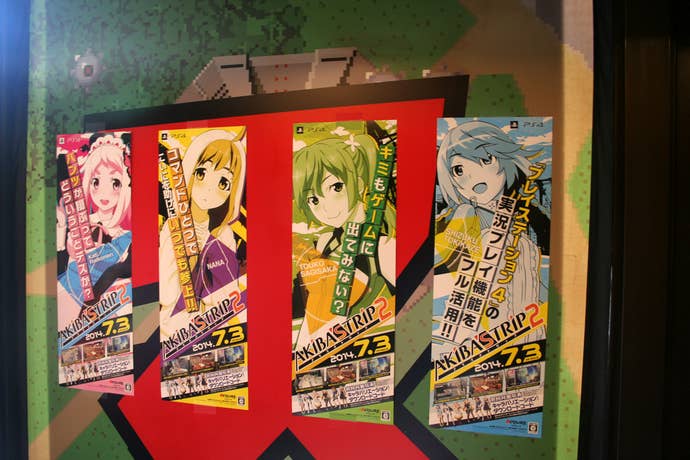
Americans in particular have long struggled to understand the very different approach Japanese culture and media have to sexuality from their own (Bayonetta 2 being but the latest in a long line of hotly debated topics). While it's easy to write that up to America's puritanical spirit, the truth is, Japan struggles with its own sexual mores as well. It's only been within the past few months that the country has finally outlawed child pornography, long the topic of a raging debate within the country.
This law — along with the fact that amidst this ban manga- and anime-based depictions of underage sex and nudity remain legal — has made plenty of headlines around the world. Meanwhile, less space has been given in the Western press to the history of Japanese laws concerning nudity in general (though the activist work of artist Megumi Igarashi has proven sufficiently salacious to earn its share of not-work-safe coverage). For example, Japanese law forbade any and all depictions of pubic hair until the 1990s, a ban that some media critics suggest helped lead to the rise of child pornography in the first place by creating an associative link between pornography and hairlessness reminiscent of prepubescence.
All of this is to say that the peculiar intersection between media, sex, and youth which has given rise to the types of games many people regard as synonymous with Japan owes its existence to a number of factors spanning decades. It's easy to hand-wave it all with a belittling "Oh, Japan" attitude, or to chalk it up to the rise of so-called "herbivore" men, or any number of other overly simplistic single-source explanations. But none of these factors alone tell the full story.
In any case, the narrative that hyper-sexualized cartoon teenagers somehow represent the sum total of Japan's unique video game output, or even a significant fraction of it, is neither accurate nor productive. Softcore visual novels and titillating anime action games are as much a niche in their home territory as they are overseas. To judge by shops and billboards in Akihabara, those games rule the country, but outside of that highly focused retail district, titles like Senran Kagura and Katawa Shoujo fade into the background beside the likes of Monster Hunter.
That niche survives because it has essentially become the fallback position for games that don't ape the AAA style. A Japanese developer who asked to remain anonymous admitted to an associate of mine that he wasn't a fan of making otaku-oriented games, but that it made good business sense. "With games like that, you know you're going to sell 40,000 copies," he said. "If you don't cater that audience, you run the risk of selling 10,000. It's safer to go with the sure thing."
But those games will never break out of their niche status. Even foreign games like Destiny and Call of Duty have a stronger point-of-purchase presence at mainstream Japanese retail than the likes of Akiba's Trip. That's quite a change from the state of things a decade ago, where localized games represented a sad, unloved corner of every Japanese shop. Even as Japan's game retail spaces have shrunken in size, the presence of Western titles has grown.
Observations over drinks
One niche that defies the shrinkage of Japan's fading love for classic games is the retrogame bar scene. These small bars offer a quiet (and often quite crowded) escape for fans to enjoy a drink — themselves often themed around a classic game — while playing old cartridges or Virtual Console games for a few hours. Places like Shinjuku's 8-Bit Cafe or Nakano's B-Dash offer game lovers a welcome alternative to arcades, which are noisy, crowded, and aggressive. The booze may be weak and overpriced, but the opportunity to chill out with like-minded friends and strangers and pass the controller to conquer a beloved oldie like Spelunker or Mega Man 2 more than makes up for the surcharge attached to the drinks.
Where game shops and arcades alike have begun to dry up and disappear over the past few years, there are more retrogame bars in Tokyo today than in 2008. Outside of a rumored shakeup a couple of years ago as Nintendo cracked down on naming rights — Shibuya's Famicom Cafe closed down altogether, and Shinjuku's Muteki Mario changed its name to Star*Club — these watering holes have remained thriving spots for game fans and creators alike to wind down after hours. They've also helped inspire a number of "barcades" in the U.S., such as San Francisco's Soda Popinsky and Raleigh's newly opened Boxcar.
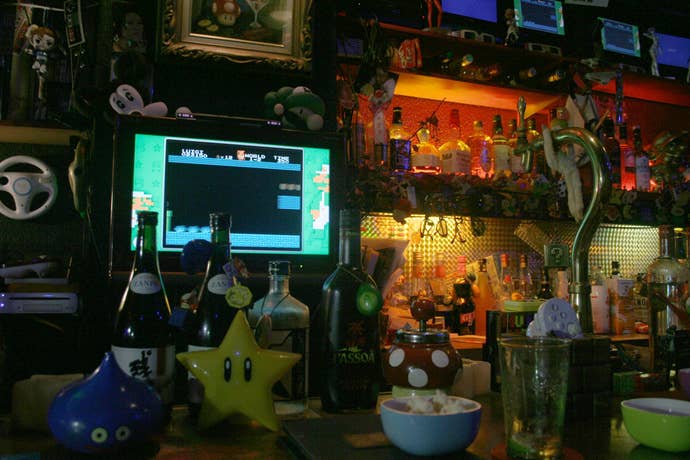
No trip to cover TGS is complete without a trip to a retrogame bar or two. This year, though, I found myself drawn for the first time ever into a loosely interpreted conversation with a couple of Japanese game fanatics while enjoying one of Star*Club's pricey custom game cocktails (a sweet, milk-based concoction named after the Super Mario Bros. series' Boos). We spoke for a while about the complicated localization history and Western numeration of the classic Super Mario and Final Fantasy games — a topic that only dedicated enthusiasts know about even in the U.S. But my Japanese counterparts seemed quite interested in, and knowledgeable about, the 8- and 16-bit stumbles of those series as they made their way overseas.
As we spoke more, I began to realize that despite the popular conception that Japanese gamers look down upon Western-developed software as poor or inferior, my new barfly friends were actually quite enthusiastic for American and European games. They seemed particularly disappointed when I named some of the most popular games in the U.S. (things like Assassin's Creed and Call of Duty) but only, I realized, because they were already familiar with those games and were hoping to learn about more exotic trivia.
The stereotype that Japanese gamers believe "yoge kusoge" ("foreign games are crap") still holds true to a certain degree — snarky remarks on popular social boards like 2chan leave no doubt of that — but it no longer feels like the prevailing sentiment. Sure, the Microsoft booth at TGS was probably the least lively corner of the show, even on crowded public days, but elsewhere on the floor Western games (including Dragon Age: Inquisition and Evolve) drew sizable audiences.
The more I spoke to people both at TGS and in the days following, I found that my Star*Club encounter was by no means atypical. The Japanese games community is developing a growing interest in games from the West. Indie games in particular seem to be of interest; several different people told me that there's tremendous enthusiasm for Shovel Knight, and that Spelunky became a sizable hit when it hit Japan's PlayStation Network.
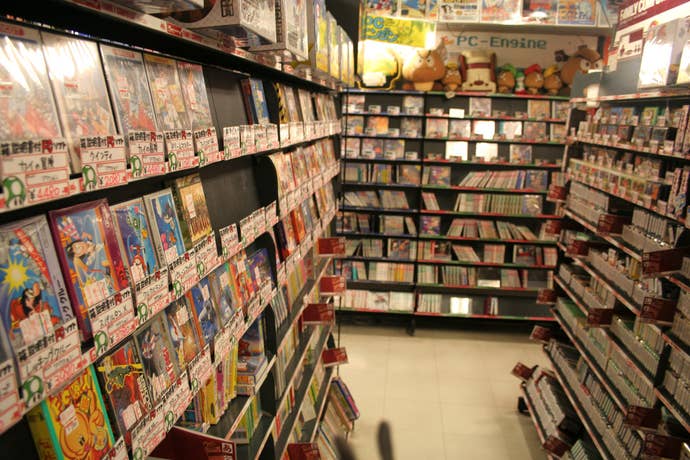
For those who subscribe to the popular narrative that Japanese developers need to embrace the West in order to thrive, this slow turn of events must sound like sweet vindication. But I don't think it proves them right. Western games and developers won't save the Japanese games industry. Many Japanese publishers seemed to operate under that premise throughout the last console generation, and for the most part it only led to heartbreak. Capcom and Konami make active efforts to adopt the processes, styles, and even talent of Western studios, and in the long terms it hasn't particularly paid off. Capcom's current lineup consists of internally developed projects, and Konami has all but abandoned console games in favor of mobile titles and their external businesses, such as fitness gyms and casino machines.
No, Japanese games and developers will save the Japanese games industry, and they'll likely do so by taking the time to understand what works about about Japanese and Western games and draw from the best of both worlds. Last generation we saw Japanese studios all too eager to throw away their distinct identity and imitate American and European creations — but those were literally imitative works, mimicking the form without properly grasping the underlying reasons for success. When Final Fantasy XIII's staff told me the game looked to Call of Duty for inspiration, they ultimately were referring only to the linear, cutscene-driven design of FFXIII rather than anything to do with the immersion of Modern Warfare's point of view or the addictive, compulsive design of the multiplayer game. They spoke from awareness, not from experience.
On the other hand, when Final Fantasy XV director Hajime Tabata talked about how excited he was for Destiny the day it launched in Japan, his comment had the ring of sincerity. When Tales of Xillia producer Hideo Baba joked that he would rather be playing Destiny than sitting in a press roundtable, the way he stage-whispered "Destiny" before making finger guns at his interviewers gave the impression of someone who had bought into the hype. Where in the past, I've heard Japanese developers cite foreign games with a sort of grim detachment — a grudging acceptance of comparative sales figures and the need to follow the money, however reluctantly — more and more the attitude has changed to one of genuine enthusiasm. The younger generation of designers has begun to slip into leadership roles at even the oldest guard of the Japanese industry, and they bring with them an openness to outside experiences that previously seemed almost like heresy.
In the end, this acceptance can only make Japanese games better. Not because Western games are inherently superior, but because diversity invariably makes for better work. The same way Japanese influences have made many Western games better. Japan's enthusiasm for games like Shovel Knight and Spelunky bears this out: Those games come from Western designers who grew up playing loving classic Japanese 8-bit classics, dissected and reinterpreted them with an outside perspective, and came up with works that feel like modern-day successors to the works that inspired them. They excel through their creators' love for and intimate understanding of both Japanese and Western principles, and as a result they've earned a following in both territories.
This, in the end, may be the saving grace. There may be no way to halt Japan's aging, or the shrinking of the population, or the isolation of otaku gamers as an unloved niche demographic, or the country's overall shift to mobile gaming. Of the top 100 best-selling games in Japan since 2000, 39 were for Nintendo DS, and 22 were for PlayStation 2. By comparison, only 8 have been for 3DS, and only one was for PlayStation 3 (16 appeared on Wii). Those numbers will be difficult to reverse.
But if Japan's creators can apply the same borderless outlook to their creations that the best Western indie designers have employed, it won't matter. Games made by people who recognize the reasons for the popularity of major American and European franchises without sacrificing the personality and aesthetics that Japanese pop culture brings to the table can excel the world over. Better yet, they could be a breath of fresh air amidst the increasing sameness of Western AAA design. A revitalized Japanese games industry might not just save itself, but Western games as well.
A few years ago, as try-hard games like Resident Evil 6 flailed and failed in their attempts to copy Western blockbuster, such a turn of events seemed unlikely to ever come to pass. But after this year's Tokyo Game Show, I came away feeling optimistic for the first time in ages — not just from the show itself, but from all the informal conversations I had on the side. These may be anecdotal experiences, but sometimes the man on street tells the best story... especially when until recently you weren't sure if the man on the street even cared.
Granted, this may not do much to restore Tokyo's flagging retrogame market. But in the end, it's probably better to focus on insuring a future than enshrining the past.
Photography courtesy of Kyle McLain. Please note that this feature is based on several months' worth of conversations, interviews, and research. However, due to informal manner in which I've presented that information and my conclusions, not to mention my status as an outside observer to the matter at hand, it is by no means meant to be a definitive treatise. Any and all corrections, counterpoints, or corroborations are welcome in the comments section below.




